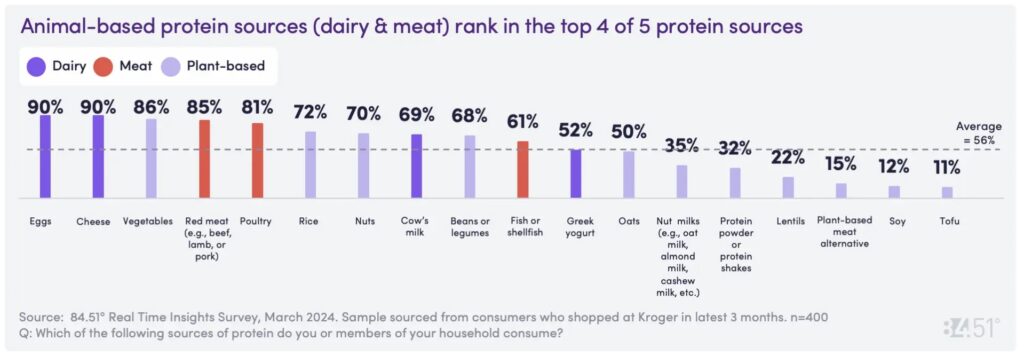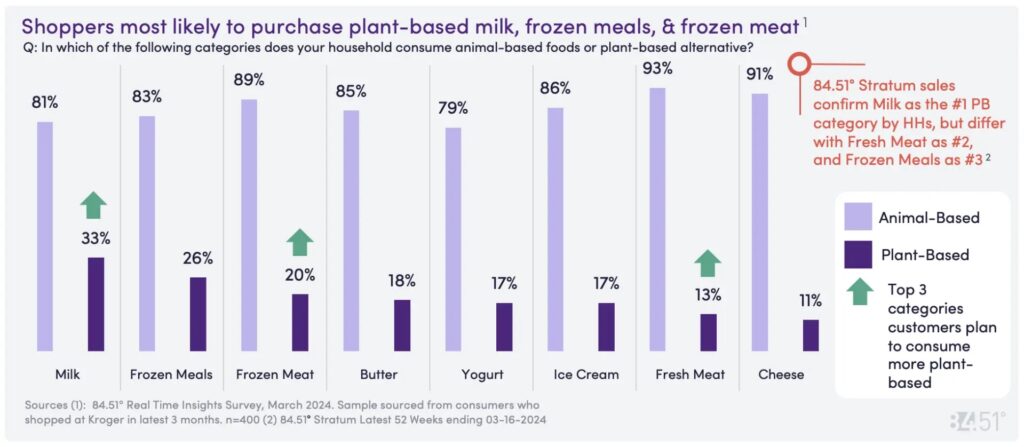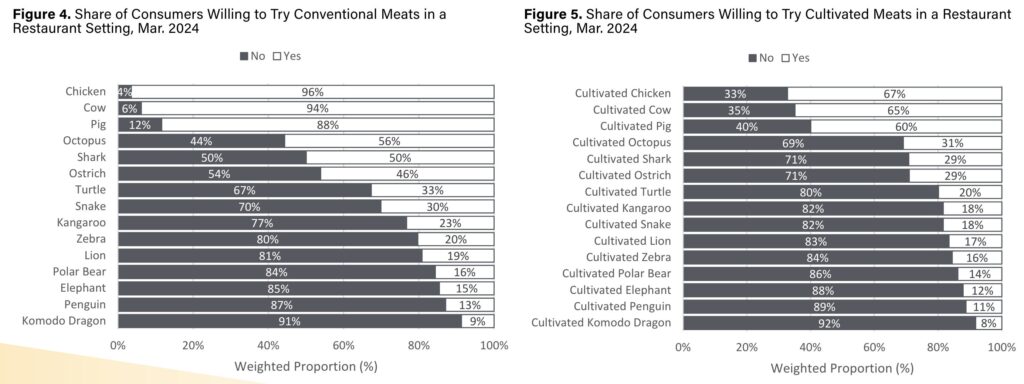Health Remains Americans’ Key Consideration for Plant Proteins and Cultivated Meat
6 Mins Read
As plant-based meat companies rejig their nutritional messaging and cultivated meat battles to shake off the ‘lab-grown’ tag and political attacks, two consumer surveys reveal that health remains a key priority for Americans when it comes to alternative proteins.
The overconsumption of meat in the US is a major driver of the country’s large climate footprint, with one analysis showing that Americans’ red meat intake is over six times higher than advised by the Eat-Lancet Commission’s Planetary Health Diet.
Only 12% of Americans consume half of all the beef eaten in the US, and about 40% don’t think eating red meat increases greenhouse gas emissions – despite beef being the most polluting food. Separate research shows that as many as 74% of Americans don’t link meat-eating with climate change, while one estimate suggests the country needs to cut meat consumption by 82% if it wants to avoid climate diasters in the future.
And while the number of vegans hit a decade-long low in the US last year, another poll suggests that the percentage of consumers who are eating plant-rich diets has doubled over the last few years – but the red-meat-eaters have also grown in number. The paradoxical results of all these surveys show that there’s certainly interest in plant-based eating in the US, but meat still rules the roost.
That paradox is also highlighted by two new surveys about food in the country, covering cost of living, animal protein, plant-based proteins and cultivated meat.
Plant-based brands will find it hard to sway new customers
The first of these surveys is the March Consumer Digest by data science firm 84.51°, which polled 400 consumers who shopped from Kroger in the last three months.
It reveals that the higher cost of living continues to influence consumer behaviour significantly, adjusting meal plans to include dishes that use less meat (43% are doing so); purchasing more beans, legumes, nuts and eggs (33%); and reducing protein consumption (18%).

When it comes to the latter, shoppers are most concerned with taste (60%) and value (55%), while plant-based sources are among the factors they’re least concerned with (45%). In fact, animal protein sources take up four of the top five spots in the list of preferred protein sources, with vegetables (cited by 86%) third on the list, although they are above all meat sources.
Other plant proteins are much lower on the list, with tofu coming in last (11%), just behind soy (11%), plant-based meat (15%) and lentils (22%). 84.51° reveals that plant-based milk often serves as an entry point for vegan food consumption, which is apparent when you consider that milk is the vegan category households consume most (33%). It’s also among the top three segments that Americans want to consume more of, alongside fresh and frozen plant-based meats.

For 59% of respondents, health is the most important consideration pushing them to eat plant-based, followed by sustainability (42%) and taste (38%). This is exactly why industry leaders like Beyond Meat and Impossible Foods have shifted their messaging of late, introducing nutrition-focused products, packaging and marketing campaigns.
When it comes to consumption barriers, cost is key to 53%, while 41% are dismayed by low sales or promotions. And it seems that companies in this space face an uphill battle to lure consumers, with nearly half (48%) of people who haven’t tried vegan analogues saying they aren’t likely to do so in the future – only 5% say they’re very likely to try them.

Cultivated meat may need to tackle the uncommon
Researchers at Purdue University’s Center for Food Demand Analysis and Sustainability, meanwhile, surveyed 1,200 Americans for its March Consumer Food Insights Report, revealing that while Americans do prefer conventional meat more than cultivated, the latter isn’t too far behind (considering its current scale and availability) when it comes to a restaurant setting.
For example, while 96% of Americans would try chicken in restaurants, two-thirds (67%) would be willing to do so with cultivated chicken as well. This is similar for conventional versus cultivated beef (94% and 65%, respectively) and pork (88% vs 60%).
“We see similar results when evaluating consumers’ willingness to try conventional and cultivated meats in a restaurant setting,” said lead author Joseph Balagtas, a professor of agricultural economics at Purdue. “The proportion of consumers willing to try the cultivated versions of these meats is around 30 percentage points lower, though it is still a majority, about 60%.”
He added: “Given the fact that cell-cultured meat is not widely available, these results reflect consumer distrust of the unknown when it comes to food, which is a barrier for any novel food trying to break into the market.”

Interestingly, of those respondents not willing to try conventional chicken, beef or pork, around 46%, 26% and 22% said they’d eat cultivated versions of these products, respectively. “This shows that there may be (a) market for cultivated meat among a sizable portion – albeit small number – of consumers who do not eat meat along with a majority of consumers who already are willing to try conventional versions of these meats,” Balagtas said.
In terms of health, consumers felt traditionally farmed meat is tastier and healthier than cultivated versions. On a scale of 0 to 5, beef (4.4) and chicken (4.2) ranked high on the flavour aspect, versus 2.7 each for their cultivated counterparts. Similarly, beef scored 3.4 and chicken 4.2 when considering their health credentials, compared to 2.6 and 2.9 for cultivated beef and chicken, respectively.

The report also looked at certain ‘exotic meats’ – like octopus, shark and ostrich (among others) – where acceptance for conventional versions was higher than cultivated meats, but it is mostly a minority of consumers who are willing to try either of these products. Other animals included kangaroo and zebra too – this is topical considering Australian company Vow, which last week became the fourth company globally to receive regulatory approval for cultivated meat, has been known to work with cells of these species.
Its debut product itself is somewhat out of the ordinary. The company has produced cultivated quail as part of a parfait, and its co-founder and CEO George Peppou outlined why cultivated meat companies need to stop recreating conventional meats, and produce entirely new foods instead. “By changing the process of production, rather than the food itself, you are asking consumers to change their behaviour for the benefit of the planet alone. Despite what we’d like to believe, those externalities don’t matter as much as we think to a vast majority of consumers when it comes to purchasing,” he told Green Queen last week.
It encapsulates the results of the Purdue survey – there’s much less gap between acceptance for the cultivated and conventional versions of ‘exotic’ meats than for chicken, beef and pork. “The only way for us to change our behaviour is to offer new foods that consumers choose selfishly. That’s why Vow is different, because we innovate instead of imitating, and therefore offer something that consumers will selfishly choose, because it is deliberately different.



